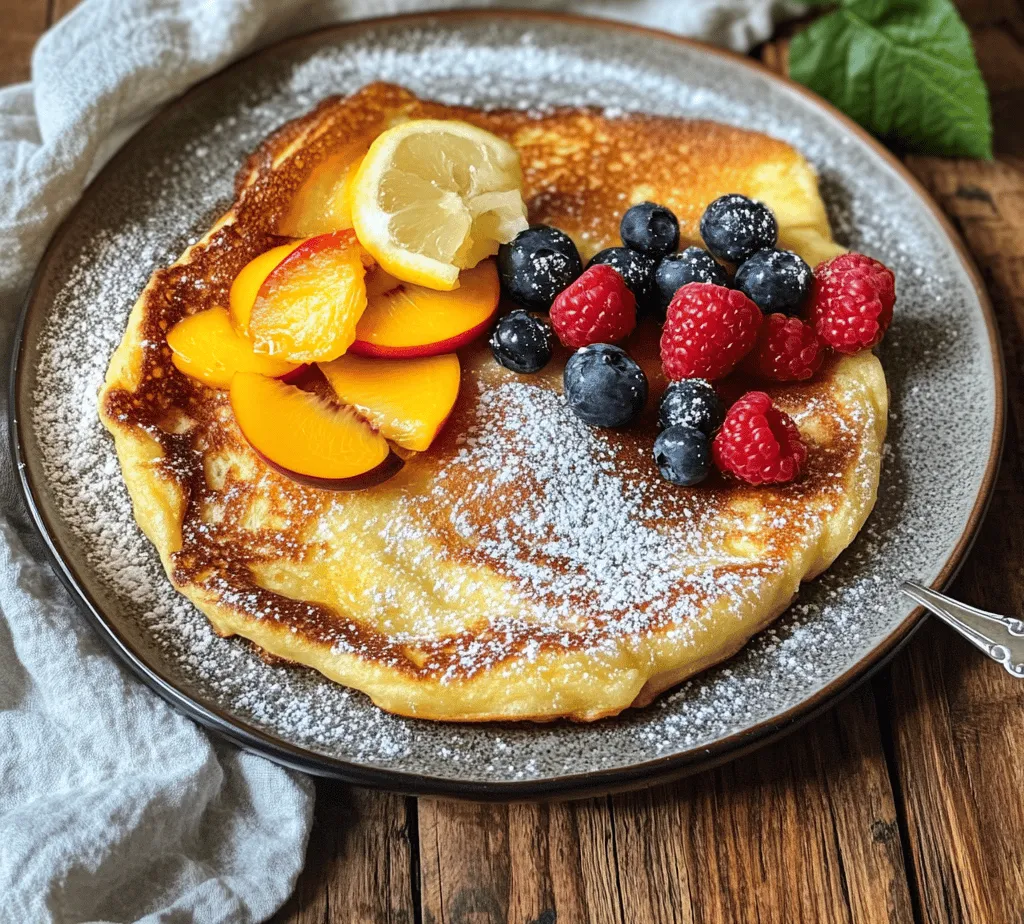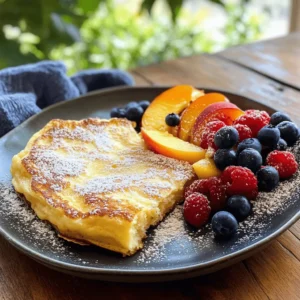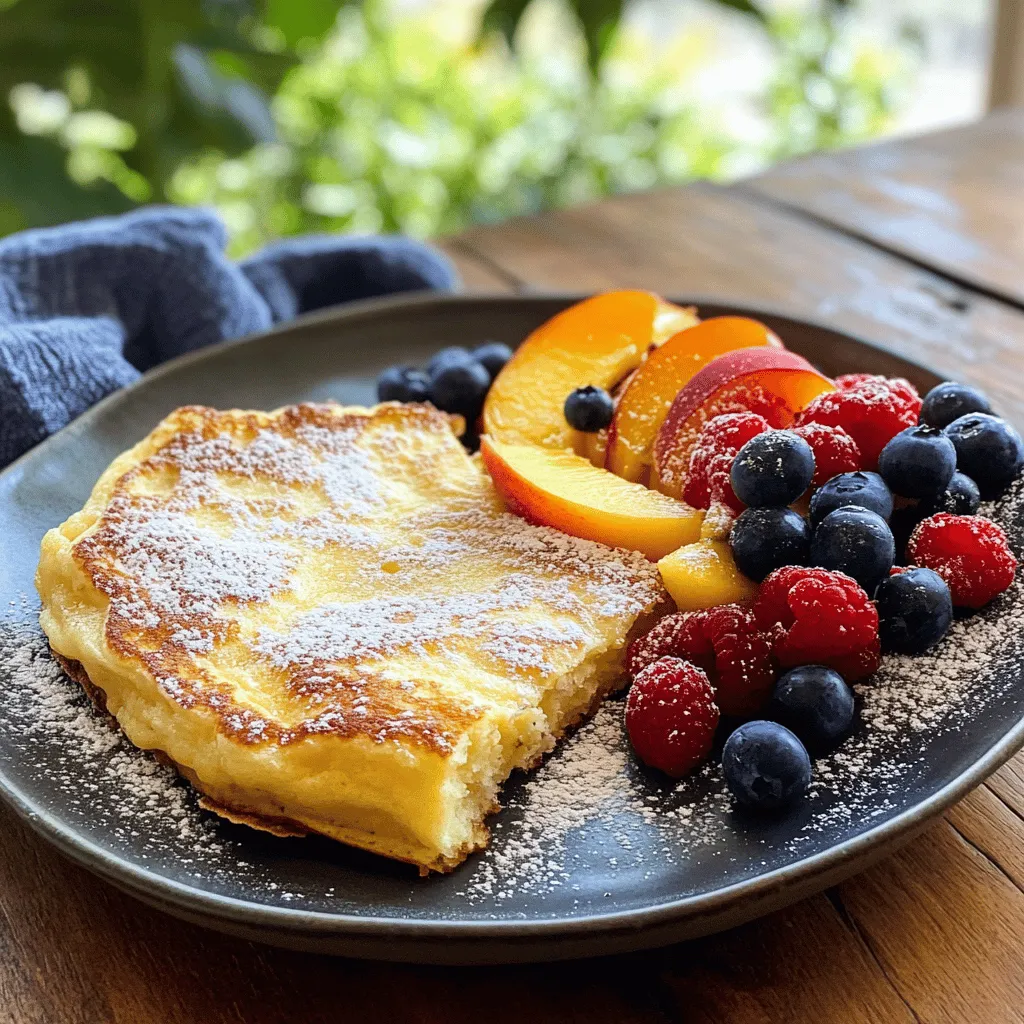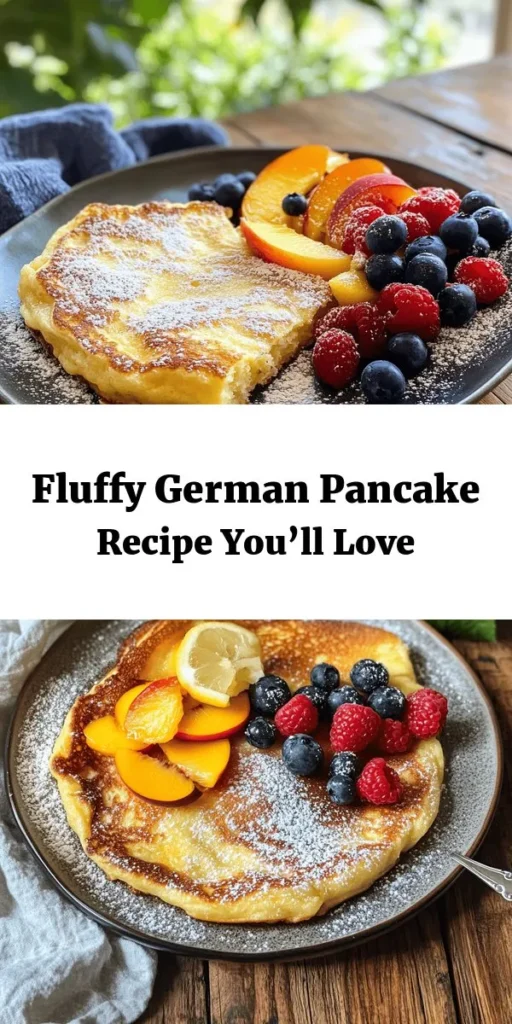Introduction
German pancakes, also known as Dutch babies, have become a beloved breakfast and brunch staple in many households. Their popularity stems not only from their deliciously unique flavor but also from their impressive appearance and ease of preparation. Unlike traditional pancakes, which are cooked on a griddle, German pancakes are baked in the oven, resulting in a puffy, airy texture that is sure to impress anyone at the breakfast table.
The fluffy baked German pancake is characterized by its delicate, custard-like interior and crisp, golden edges. As it bakes, the pancake rises dramatically, creating a stunning centerpiece for any meal. This dish is not only visually appealing but also incredibly versatile; it can be served sweet or savory, accommodating a variety of tastes and preferences. Whether topped with fresh fruits, a sprinkling of powdered sugar, or a drizzle of maple syrup, the possibilities are endless, making it an ideal choice for family gatherings or leisurely weekend brunches.
What makes the fluffy baked German pancake especially appealing is its simplicity. With just a handful of ingredients and minimal prep time, you can whip up this delightful dish in no time. It’s an excellent opportunity to gather your loved ones around the table and enjoy a warm, satisfying breakfast together.
Understanding the Fluffy Baked German Pancake
To fully appreciate the fluffy baked German pancake, it’s essential to understand its origins and how it differs from other types of pancakes. The term “German pancake” can be somewhat misleading, as this dish is not traditionally German. Instead, it is believed to have originated in the United States, particularly in the Pacific Northwest, where German immigrants brought their culinary traditions.
German pancakes are distinct from traditional pancakes in several key ways. First, they are baked in the oven rather than cooked on a stovetop. This baking method allows the batter to rise and develop its signature fluffy texture. Additionally, German pancakes typically contain a higher ratio of eggs and milk compared to the standard pancake batter, resulting in a richer and more custard-like consistency.
Another point of comparison is with crêpes, which are thin, delicate pancakes often served with sweet or savory fillings. While crêpes are cooked quickly on the stovetop and have a flat, tender texture, German pancakes rise significantly during baking and have a more substantial bite. The result is a delightful contrast between the airy, fluffy interior and the slightly crisp edges, making each bite a delicious experience.
Culturally, German pancakes hold a special significance in various regions, particularly in the United States. They are often associated with family gatherings, brunches, and special occasions, evoking a sense of nostalgia and comfort. The dish has garnered a loyal following, with many families passing down their favorite recipes through generations.
Ingredients Breakdown
Creating the perfect fluffy baked German pancake requires a few essential ingredients, each playing a crucial role in achieving the desired texture and flavor. Let’s take a closer look at these ingredients and their contributions to this delightful dish:
– Eggs: Eggs are the backbone of the fluffy baked German pancake, providing structure and stability. The high protein content in eggs helps the pancake rise during baking, creating that characteristic puffiness. Additionally, they contribute to the overall richness and custardy texture.
– Whole Milk: Whole milk is essential for adding creaminess and moisture to the batter. It helps create a smooth, pourable consistency and enhances the flavor profile of the pancake. Using whole milk ensures a richer taste, but you can substitute with lower-fat options if desired, though the texture may vary slightly.
– All-Purpose Flour: All-purpose flour acts as the binding agent in the batter, giving the pancake its structure. It helps trap air during baking, contributing to the fluffy texture. For best results, sift the flour to avoid clumps and ensure an even distribution throughout the batter.
– Granulated Sugar: Sugar not only sweetens the pancake but also aids in browning. When baked, the sugar caramelizes on the edges, creating a lovely golden crust that contrasts beautifully with the soft interior. Adjust the amount according to your taste preference, especially if you plan to serve the pancake with sweet toppings.
– Vanilla Extract: A splash of vanilla extract elevates the flavor of the pancake, adding depth and aroma. It complements the sweetness of the sugar and enhances the overall taste profile. For an extra touch of flavor, consider using high-quality pure vanilla extract.
– Salt: A pinch of salt is vital for balancing the sweetness of the pancake. It enhances the flavors and rounds out the overall taste, making each bite more enjoyable. Don’t skip this ingredient, as it plays a crucial role in flavor development.
– Unsalted Butter: Butter is responsible for adding richness and crispiness to the pancake. It is typically melted and added to the batter, contributing to a delightful texture. Additionally, butter can be used to grease the baking dish, ensuring that the pancake releases easily after baking.
– Optional Toppings: While the fluffy baked German pancake is delicious on its own, you can take it to the next level with various toppings. Fresh fruits such as berries, sliced bananas, or citrus segments add a refreshing burst of flavor. A dusting of powdered sugar provides a touch of sweetness, while a squeeze of lemon juice brightens the dish and cuts through the richness.
Preparation Steps Detailed
Now that you have a clear understanding of the ingredients, the next essential step in preparing a fluffy baked German pancake is preheating the oven.
Preheating the Oven
Preheating your oven is a crucial step that should not be overlooked. It ensures that your pancake bakes evenly and achieves the perfect rise. Set your oven to 425°F (220°C) and allow it to heat fully before placing the pancake in. This high temperature is essential for creating the signature puffiness that defines a German pancake.
While the oven is preheating, you can prepare the batter. This involves gathering your ingredients and measuring them out accurately. Having everything ready before you start mixing will help streamline the process and ensure a smooth preparation.
Once your oven has reached the desired temperature, you’ll be ready to mix the batter and bake your delicious fluffy baked German pancake. The anticipation of watching it puff up in the oven is part of the joy of making this dish, making it a fun experience for both novice and seasoned cooks alike.
Stay tuned for the next section, where we will dive into the detailed preparation steps, ensuring you achieve the perfect fluffy baked German pancake that will wow your family and friends.

Blending the Batter
Achieving a smooth and frothy batter is crucial for creating the signature texture of a fluffy baked German pancake. Start by gathering all your ingredients: eggs, milk, flour, sugar, and salt. It’s best to use room temperature eggs and milk, as they blend more easily and help create a lighter batter.
When blending, consider using a blender or an immersion blender for the best results. These tools not only make the process quicker but also aerate the mixture, adding volume and ensuring a smooth consistency. Mix the eggs and milk first until they are well combined, then gradually add the flour and sugar. Blend on low speed initially to avoid a flour cloud, then increase to medium until the batter is completely smooth and slightly frothy. If you prefer a more traditional method, a whisk can be used, but it may take more elbow grease to achieve the desired texture.
Melting the Butter
Melting the butter properly is another key step in this recipe. Start by preheating your oven to 425°F (220°C). As the oven heats, place a cast-iron skillet or a heavy baking dish in the oven to warm up. Once the dish is hot, carefully remove it (using oven mitts) and add the butter.
It’s important to let the butter melt completely in the hot dish to ensure an even coating that prevents sticking. Swirl the pan gently, allowing the melted butter to coat the bottom and sides. This not only adds flavor but also creates that crispy edge that contrasts beautifully with the fluffy interior. If desired, you can add a sprinkle of cinnamon or a dash of vanilla extract to the melted butter for an extra layer of flavor.
Pouring and Baking
The act of pouring the batter into the hot dish is crucial for achieving the pancake’s trademark puffiness. Gently pour the batter into the center of the dish. The heat from the pan causes the batter to cook instantly, creating steam that lifts the pancake. This is where the magic happens!
Once you’ve poured the batter, return the dish to the oven immediately. Make sure not to open the oven door during the first 10 minutes of baking, as this can cause the pancake to deflate. Baking times may vary depending on your oven, but typically, it should take around 20-25 minutes.
Baking for Perfection
As your German pancake bakes, keep an eye on it. You’ll know it’s ready when the edges begin to rise dramatically, creating a beautiful golden-brown crust. The center should be puffed and set, with a slight jiggle when you gently shake the pan. Avoid overbaking, as this can turn the pancake dry.
Once it’s done, remove it from the oven and allow it to cool for a minute before serving. The pancake will start to deflate slightly, which is perfectly normal and adds to its appeal.
Serving Suggestions
There are countless ways to serve a fluffy baked German pancake, making it a versatile dish that can be enjoyed for breakfast, brunch, or even dessert.
Creative Ways to Serve: Consider cutting the pancake into wedges and serving it straight from the skillet for a rustic presentation. You can also transfer slices to individual plates for a more formal look.
Pairing with Various Toppings:
– Fresh Fruits: Seasonal fruits such as berries, sliced bananas, or apples not only add a burst of color but also bring freshness and natural sweetness. The nutritional benefits of fruits, like vitamins and antioxidants, enhance the overall value of your meal.
– Powdered Sugar and Lemon Juice: A dusting of powdered sugar, paired with a squeeze of fresh lemon juice, creates a delightful contrast of sweet and tart flavors. This combination elevates the presentation and adds an elegant touch.
Suggestions for Accompanying Beverages: Complement your pancake with a hot cup of coffee or tea for a cozy breakfast experience. Alternatively, refreshing fruit juices, like orange or apple, can provide a light and vibrant pairing that balances the richness of the pancake.
Nutritional Information
A fluffy baked German pancake is not only delicious but can also be part of a balanced meal.
Overview of Nutritional Content: Each serving typically contains around 200-300 calories, depending on the size and toppings. It offers a good source of protein from the eggs and milk, along with carbohydrates from the flour.
Discussion of Serving Sizes and Dietary Considerations: A standard serving size is one wedge, but feel free to adjust based on your appetite and dietary needs. For those watching their caloric intake, pairing the pancake with fresh fruits rather than rich toppings can provide a satisfying yet lighter meal.
Suggestions for Healthier Ingredient Swaps: If you’re looking to make a healthier version, consider substituting all-purpose flour with whole-grain flour, which adds fiber and nutrients. You can also use almond milk or oat milk instead of regular milk for a dairy-free option. For a lower sugar variant, reduce the sugar in the batter or use a natural sweetener like honey or maple syrup.
Frequently Asked Questions
Common Inquiries Regarding the Baking Process:
1. Why did my pancake deflate? – Deflation often occurs when the pancake is removed from the oven or if the batter was overmixed. Make sure to pour the batter into a hot dish and avoid opening the oven door during baking.
2. What if my pancake is unevenly cooked? – This can happen if the oven temperature is inconsistent. Ensure your oven is preheated properly, and consider using an oven thermometer for accuracy.
Troubleshooting Tips: If your pancake is not rising as expected, check the freshness of your eggs and baking powder, as expired ingredients can affect leavening.
Variations of the Recipe: Feel free to experiment with flavors! Adding vanilla extract or almond extract can enhance the flavor profile. You can also fold in some cocoa powder for a chocolatey twist or sprinkle in cinnamon for a warm spice.
Conclusion
Making and enjoying a fluffy baked German pancake is a delightful experience that brings warmth and comfort to any meal. Its versatility allows it to shine at breakfast, brunch, or even as a light dessert, accommodating a variety of tastes and preferences.
Whether you stick to the traditional toppings or get creative with your own combinations, this recipe is sure to become a family favorite. So gather your ingredients, preheat that oven, and enjoy the simple pleasure of creating this fluffy delight in your kitchen!



